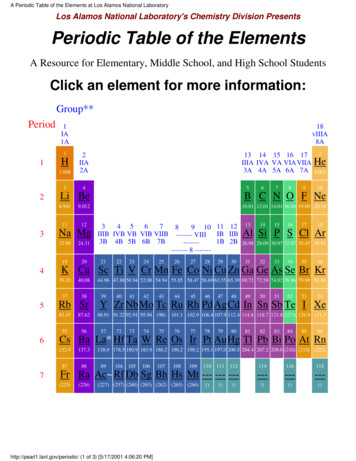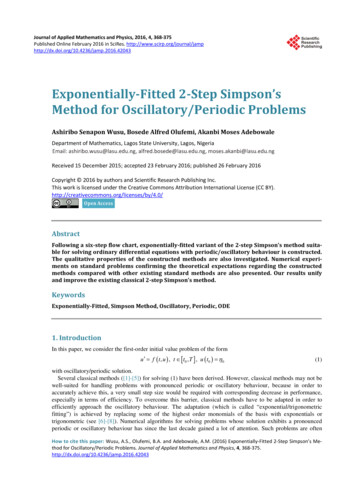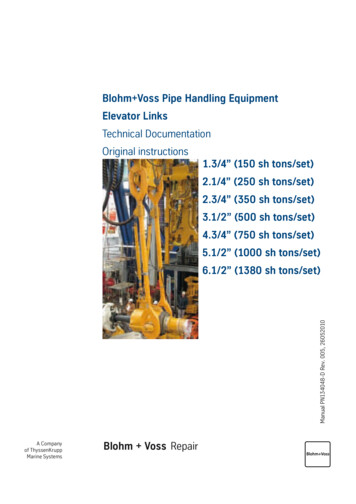
Transcription
A Periodic Table of the Elements at Los Alamos National LaboratoryLos Alamos National Laboratory's Chemistry Division PresentsPeriodic Table of the ElementsA Resource for Elementary, Middle School, and High School StudentsClick an element for more 082IIA2A34H13 14 15 16 17IIIA IVA VA VIA VIIA3A 4A 5A 6A 7A5Li Be6.9419.0121112Na Mg22.9924.31192067892He4.00310B C N O F Ne10.81 12.01 14.01 16.00 19.00 20.1834 56789 10 11 12IIIB IVB VB VIB VIIB ------- VIIIIB IIB3B 4B 5B 6B 7B1B2B------------- 8 ------21222324252627282930131415161718Al Si P S Cl Ar26.98 28.09 30.97 32.07 35.45 39.95313233343536K Ca Sc Ti V Cr Mn Fe Co Ni Cu Zn Ga Ge As Se Br Kr39.1040.083738Rb Sr85.4787.62555644.96 47.88 50.94 52.00 54.94 55.85 58.47 58.69 63.55 65.39 69.72 72.59 74.92 78.96 79.90 83.8039404142434445464748495051525354Y Zr Nb Mo Tc Ru Rh Pd Ag Cd In Sn Sb Te I Xe88.91 91.22 92.91 95.94 (98)5772737475101.1 102.9 106.4 107.9 112.4 114.8 118.7 121.8 127.6 126.9 131.37677787980818283848586Cs Ba La* Hf Ta W Re Os Ir Pt Au Hg Tl Pb Bi Po At Rn132.9137.38788138.9 178.5 180.9 183.9 186.2 190.2 190.2 195.1 197.0 200.5 204.4 207.2 209.0 (210) (210) (222)112114116118Fr Ra Ac Rf Db Sg Bh Hs Mt --- --- ------------()()()(223)(226)89104 105106107108109(227) (257) (260) (263) (262) (265) (266)http://pearl1.lanl.gov/periodic/ (1 of 3) [5/17/2001 4:06:20 PM]110()111()()
A Periodic Table of the Elements at Los Alamos National Laboratory58Lanthanide Series*59606162636465666768697071Ce Pr Nd Pm Sm Eu Gd Tb Dy Ho Er Tm Yb Lu140.1 140.9 144.2 (147) 150.4 152.0 157.3 158.9 162.5 164.9 167.3 168.9 173.0 175.090Actinide Series 919293949596979899100101102103Th Pa U Np Pu Am Cm Bk Cf Es Fm Md No Lr232.0 (231) (238) (237) (242) (243) (247) (247) (249) (254) (253) (256) (254) (257)** Groups are noted by 3 notation conventions.For a list of a the element names and symbols in alphabetical order, click hereDownload this Web Site to your computer (Adobe Acrobat format - PDF)Get Adobe Acrobat Reader for freeQuestions - Comments - FeedbackSend an email to cstis@lanl.govWhat is the Periodic Table?How to use the Periodic TableClick here to see Mendeleev's original PeriodicTableChemistry in a NutshellNaming New Elements[ LANL DOE Disclaimer ]Last Updated: 5/10/2001http://pearl1.lanl.gov/periodic/ (2 of 3) [5/17/2001 4:06:20 PM]
A Periodic Table of the Elements at Los Alamos National Laboratoryabout this resourcehttp://pearl1.lanl.gov/periodic/ (3 of 3) [5/17/2001 4:06:20 PM]
HydrogenHydrogenFor rocket fuelAtomic Number:1Atomic Symbol:HAtomic Weight:1.0079Electron Configuration: 1s1History(Gr. hydro, water, and genes, forming) Hydrogen was prepared many years before it was recognized as adistinct substance by Cavendish in 1776.Named by Lavoisier, hydrogen is the most abundant of all elements in the universe. The heavier elementswere originally made from Hydrogen or from other elements that were originally made from Hydrogen.SourcesHydrogen is estimated to make up more than 90% of all the atoms or three quarters of the mass of theuniverse. This element is found in the stars, and plays an important part in powering the universe throughboth the proton-proton reaction and carbon-nitrogen cycle -- stellar hydrogen fusion processes thatrelease massive amounts of energy by combining Hydrogen to form Helium.Production of hydrogen in the U.S. alone now amounts to about 3 billion cubic feet per year. Hydrogen isprepared by steam on heated carbon, decomposition of certain hydrocarbons with heat, action of sodium or potassium hydroxide on aluminum electrolysis of water, or displacement from acids by certain metals.Liquid hydrogen is important in cryogenics and in the study of superconductivity, as its melting point isonly 20 degrees above absolute zero.Tritium is readily produced in nuclear reactors and is used in the production of the hydrogen bomb.Hydrogen is the primary component of Jupiter and the other gas giant planets. At some depth in theplanet's interior the pressure is so great that solid molecular hydrogen is converted to solid .html (1 of 3) [5/17/2001 4:06:21 PM]
Hydrogenhydrogen.In 1973, a group of Russian experimenters may have produced metallic hydrogen at a pressure of 2.8Mbar. At the transition the density changed from 1.08 to 1.3 g/cm3. Earlier, in 1972, at Livermore,California, a group also reported on a similar experiment in which they observed a pressure-volumepoint centered at 2 Mbar. Predictions say that metallic hydrogen may be metastable; others havepredicted it would be a superconductor at room temperature.CompoundsAlthough pure Hydrogen is a gas we find very little of it in our atmosphere. Hydrogen gas is so lightthat uncombined Hydrogen will gain enough velocity from collisions with other gases that they willquickly be ejected from the atmosphere. On earth, hydrogen occurs chiefly in combination with oxygenin water, but it is also present in organic matter such as living plants, petroleum, coal, etc. It is present asthe free element in the atmosphere, but only to the extent of less than 1 ppm by volume. The lightest ofall gases, hydrogen combines with other elements -- sometimes explosively -- to form compounds.UsesGreat quantities are required commercially for the fixation of nitrogen from the air in the Haber ammoniaprocess and for the hydrogenation of fats and oils. It is also used in large quantities in methanolproduction, in hydrodealkylation, hydrocracking, and hydrodesulfurization. Other uses include rocketfuel, welding, producing hydrochloric acid, reducing metallic ores, and filling balloons.The lifting power of 1 cubic foot of hydrogen gas is about 0.07 lb at 0C, 760 mm pressure.The Hydrogen Fuel cell is a developing technology that will allow great amounts of electrical power tobe obtained using a source of hyrogen gas.Consideration is being given to an entire economy based on solar- and nuclear-generated hydrogen.Public acceptance, high capital investment, and the high cost of hydrogen with respect to today's fuels arebut a few of the problems facing such an economy. Located in remote regions, power plants wouldelectrolyze seawater; the hydrogen produced would travel to distant cities by pipelines. Pollution-freehydrogen could replace natural gas, gasoline, etc., and could serve as a reducing agent in metallurgy,chemical processing, refining, etc. It could also be used to convert trash into methane and ethylene.FormsQuite apart from isotopes, it has been shown that under ordinary conditions hydrogen gas is a mixture oftwo kinds of molecules, known as ortho- and para-hydrogen, which differ from one another by the spinsof their electrons and nuclei.Normal hydrogen at room temperature contains 25% of the para form and 75% of the ortho form. Theortho form cannot be prepared in the pure state. Since the two forms differ in energy, the physicalproperties also differ. The melting and boiling points of parahydrogen are about 0.1oC lower than thoseof normal 1.html (2 of 3) [5/17/2001 4:06:21 PM]
HydrogenIsotopesThe ordinary isotope of hydrogen, H, is known as Protium, the other two isotopes are Deuterium (aproton and a neutron) and Tritium (a protron and two neutrons). Hydrogen is the only element whoseisotopes have been given different names. Deuterium and Tritium are both used as fuel in nuclear fusionreactors. One atom of Deuterium is found in about 6000 ordinary hydrogen atoms.Deuterium is used as a moderator to slow down neutrons. Tritium atoms are also present but in muchsmaller proportions. Tritium is readily produced in nuclear reactors and is used in the production of thehydrogen (fusion) bomb. It is also used as a radioactive agent in making luminous paints, and as a tracer.Sources: CRC Handbook of Chemistry and Physics and the American Chemical Society.Last Updated: 12/19/97, CST Information Services l (3 of 3) [5/17/2001 4:06:21 PM]
HeliumHeliumFor blimpsAtomic Number:2Atomic Symbol:HeAtomic Weight:4.00260Electron Configuration: 1s2History(Gr. helios, the sun). Janssen obtained the first evidence of helium during the solar eclipse of 1868 whenhe detected a new line in the solar spectrum. Lockyer and Frankland suggested the name helium for thenew element. In 1895 Ramsay discovered helium in the uranium mineral clevite while it wasindependently discovered in cleveite by the Swedish chemists Cleve and Langlet at about the same time.Rutherford and Royds in 1907 demonstrated that alpha particles are helium nuclei.SourcesExcept for hydrogen, helium is the most abundant element found through out the universe. Helium isextracted from natural gas. In fact, all natural gas contains at least trace quantities of helium.It has been detected spectroscopically in great abundance, especially in the hotter stars, and it is animportant component in both the proton-proton reaction and the carbon cycle, which account for theenergy of the sun and stars.The fusion of hydrogen into helium provides the energy of the hydrogen bomb. The helium content ofthe atmosphere is about 1 part in 200,000. While it is present in various radioactive minerals as a decayproduct, the bulk of the Free World's supply is obtained from wells in Texas, Oklahoma, and Kansas.The only known helium extraction plants, outside the United States, in 1984 were in Eastern Europe(Poland), the USSR, and a few in India.CostThe cost of helium fell from 2500/ft3 in 1915 to 1.5 cents /ft3 in 1940. The U.S. Bureau of Mines has setthe price of Grade A helium at 37.50/1000 ft3 in ml (1 of 3) [5/17/2001 4:06:22 PM]
HeliumPropertiesHelium has the lowest melting point of any element and is widely used in cryogenic research because itsboiling point is close to absolute zero. Also, the element is vital in the study of super conductivity.Using liquid helium, Kurti and co-workers and others, have succeeded in obtaining temperatures of a fewmicrokelvins by the adiabatic demagnetization of copper nuclei.It has other peculiar properties. Helium is the only liquid that cannot be solidified by lowering thetemperature. It remains liquid down to absolute zero at ordinary pressures, but it can readily be solidifiedby increasing the pressure. Solid 3He and 4He are unusual in that both can be changed in volume bymore than 30% by applying pressure.The specific heat of helium gas is unusually high. The density of helium vapor at the normal boilingpoint is also very high, with the vapor expanding greatly when heated to room temperature. Containersfilled with helium gas at 5 to 10 K should be treated as though they contained liquid helium due to thelarge increase in pressure resulting from warming the gas to room temperature.While helium normally has a 0 valence, it seems to have a weak tendency to combine with certain otherelements. Means of preparing helium difluoride have been studied, and species such as HeNe and themolecular ions He and He have been investigated.IsotopesSeven isotopes of helium are known: Liquid helium (He4) exists in two forms: He4I and He4II, with asharp transition point at 2.174K. He4I (above this temperature) is a normal liquid, but He4II (below it) isunlike any other known substance. It expands on cooling; its conductivity for heat is enormous; andneither its heat conduction nor viscosity obeys normal rules.Uses as an inert gas shield for arc welding;a protective gas in growing silicon and germanium crystals and producing titanium and zirconium;as a cooling medium for nuclear reactors, andas a gas for supersonic wind tunnels.A mixture of helium and oxygen is used as an artificial atmosphere for divers and others working underpressure. Different ratios of He/O2 are used for different depths at which the diver is operating.Helium is extensively used for filling balloons as it is a much safer gas than hydrogen. One of the recentlargest uses for helium has been for pressuring liquid fuel rockets. A Saturn booster, like the type used onthe Apollo lunar missions, required about 13 million ft3 of helium for a firing, plus more for checkouts.Liquid helium's use in magnetic resonance imaging (MRI) continues to increase as the medicalprofession accepts and develops new uses for the equipment. This equipment has eliminated some needfor exploratory surgery by accurately diagnosing patients. Another medical application uses MRE tohttp://pearl1.lanl.gov/periodic/elements/2.html (2 of 3) [5/17/2001 4:06:22 PM]
Heliumdetermine (by blood analysis) whether a patient has any form of cancer.Helium is also being used to advertise on blimps for various companies, including Goodyear. Otherlifting gas applications are being developed by the Navy and Air Force to detect low-flying cruisemissiles. Additionally, the Drug Enforcement Agency is using radar-equipped blimps to detect drugsmugglers along the United States boarders. In addition, NASA is currently using helium-filled balloonsto sample the atmosphere in Antarctica to determine what is depleting the ozone layer.CostsMaterials which become super conductive at higher temperatures than the boiling point of helium couldhave a major impact on the demand for helium. These less costly refrigerant materials could replace thepresent need to cool superconductive materials to the boiling point of helium.Sources: CRC Handbook of Chemistry and Physics and the American Chemical Society.Last Updated: 12/19/97, CST Information Services l (3 of 3) [5/17/2001 4:06:22 PM]
LithiumLithiumFor pacemaker batteriesAtomic Number:3Atomic Symbol:LiAtomic Weight:6.941Electron Configuration: [He]2s1History(Gr. lithos, stone) Discovered by Arfvedson in 1817. Lithium is the lightest of all metals, with a densityonly about half that of water.SourcesIt does not occur free in nature; combined it is found in small units in nearly all igneous rocks and in thewaters of many mineral springs. Lepidolite, spodumeme, petalite, and amblygonite are the moreimportant minerals containing it.Lithium is presently being recovered from brines of Searles Lake, in California, and from those inNevada. Large deposits of quadramene are found in North Carolina. The metal is producedelectrolytically from the fused chloride. Lithium is silvery in appearance, much like Na and K, othermembers of the alkali metal series. It reacts with water, but not as vigorously as sodium. Lithium impartsa beautiful crimson color to a flame, but when the metal burns strongly, the flame is a dazzling white.UsesSince World War II, the production of lithium metal and its compounds has increased greatly. Becausethe metal has the highest specific heat of any solid element, it has found use in heat transfer applications;however, it is corrosive and requires special handling. The metal has been used as an alloying agent, is ofinterest in synthesis of organic compounds, and has nuclear applications. It ranks as a leading contenderas a battery anode material as it has a high electrochemical potential. Lithium is used in special glassesand ceramics. The glass for the 200-inch telescope at Mt. Palomar contains lithium as a minor ingredient.Lithium chloride is one of the most lyproscopic materials known, and it, as well as lithium bromide, isused in air conditioning and industrial drying systems. Lithium stearate is used as an all-purpose andhigh-temperature lubricant. Other lithium compounds are used in dry cells and storage /3.html (1 of 2) [5/17/2001 4:06:22 PM]
LithiumCostThe metal is priced at about 300/lb.Sources: CRC Handbook of Chemistry and Physics and the American Chemical Society.Last Updated: 12/19/97, CST Information Services l (2 of 2) [5/17/2001 4:06:22 PM]
BerylliumBerylliumFor watch springsAtomic Number:4Atomic Symbol:BeAtomic Weight:9.01218Electron Configuration: [He]2s2History(Gr. beryllos, beryl; also called Glucinium or Glucinum, Gr. glykys, sweet) Discovered as the oxide byVauquelin in beryl and in emeralds in 1798. The metal was isolated in 1828 by Wohler and by Bussyindependently by the action of potassium on beryllium chloride.SourcesBeryllium is found in some 30 mineral species, the most important of which are bertrandite, beryl,chrysoberyl, and phenacite. Aquamarine and emerald are precious forms of beryl. Beryl and bertranditeare the most important commercial sources of the element and its compounds. Most of the metal is nowprepared by reducing beryllium fluoride with magnesium metal. Beryllium metal did not become readilyavailable to industry until 1957.PropertiesThe metal, steel gray in color, has many desirable properties. As one of the lightest of all metals, it hasone of the highest melting points of the light metals. Its modulus of elasticity is about one third greaterthan that of steel. It resists attack by concentrated nitric acid, has excellent thermal conductivity, and isnonmagnetic. It has a high permeability to X-rays and when bombarded by alpha particles, as fromradium or polonium, neutrons are produced in the amount of about 30 neutrons/million alpha particles.At ordinary temperatures, beryllium resists oxidation in air, although its ability to scratch glass isprobably due to the formation of a thin layer of the tml (1 of 2) [5/17/2001 4:06:22 PM]
BerylliumUsesBeryllium is used as an alloying agent in producing beryllium copper, which is extensively used forsprings, electrical contacts, spot-welding electrodes, and non-sparking tools. It is applied as a structuralmaterial for high-speed aircraft, missiles, spacecraft, and communication satellites. Other uses includewindshield frame, brake discs, support beams, and other structural components of the space shuttle.Because beryllium is relatively transparent to X-rays, ultra-thin Be-foil is finding use in X-raylithography for reproduction of micro-miniature integrated circuits.Beryllium is used in nuclear reactors as a reflector or moderator for it has a low thermal neutronabsorption cross section.It is used in gyroscopes, computer parts, and instruments where lightness, stiffness, and dimensionalstability are required. The oxide has a very high melting point and is also used in nuclear work andceramic applications.HandlingBeryllium and its salts are toxic and should be handled with the greatest of care. Beryllium and itscompounds should not be tasted to verify the sweetish nature of beryllium (as did early experimenters).The metal, its alloys, and its salts can be handled if certain work codes are observed, but no attemptshould be made to work with beryllium before becoming familiar with proper safeguards.Sources: CRC Handbook of Chemistry and Physics and the American Chemical Society.Last Updated: 12/19/97, CST Information Services l (2 of 2) [5/17/2001 4:06:22 PM]
BoronBoronFor tennis racketsAtomic Number:5Atomic Symbol:BAtomic Weight:10.81Electron Configuration: [He]2s22p1History(Ar. Buraq, Pers. Burah) Boron compounds have been known for thousands of years, but the element wasnot discovered until 1808 by Sir Humphry Davy and by Gay-Lussac and Thenard.SourcesThe element is not found free in nature, but occurs as orthoboric acid usually found in certain volcanicspring waters and as borates in boron and colemantie. Ulexite, another boron mineral, is interesting as itis nature's own version of "fiber optics."Important sources of boron are ore rasorite (kernite) and tincal (borax ore). Both of these ores are foundin the Mojave Desert. Tincal is the most important source of boron from the Mojave. Extensive boraxdeposits are also found in Turkey.Boron exists naturally as 19.78% 10B isotope and 80.22% 11B isotope. High-purity crystalline boronmay be prepared by the vapor phase reduction of boron trichloride or tribromide with hydrogen onelectrically heated filaments. The impure or amorphous, boron, a brownish-black powder, can beobtained by heating the trioxide with magnesium powder.Boron of 99.9999% purity has been produced and is available commercially. Elemental boron has anenergy band gap of 1.50 to 1.56 eV, which is higher than that of either silicon or germanium.PropertiesOptical characteristics include transmitting portions of the infrared. Boron is a poor conductor ofelectricity at room temperature but a good conductor at high ts/5.html (1 of 2) [5/17/2001 4:06:22 PM]
BoronUsesAmorphous boron is used in pyrotechnic flares to provide a distinctive green color, and in rockets as anigniter.By far the most commercially important boron compound in terms of dollar sales is Na2B4O7.5H2O. Thispentahydrate is used in very large quantities in the manufacture of insulation fiberglass and sodiumperborate bleach.Boric acid is also an important boron compound with major markets in textile products. Use of borax as amild antiseptic is minor in terms of dollars and tons. Boron compounds are also extensively used in themanufacture of borosilicate glasses. Other boron compounds show promise in treating arthritis.The isotope boron-10 is used as a control for nuclear reactors, as a shield for nuclear radiation, and ininstruments used for detecting neutrons. Boron nitride has remarkable properties and can be used to makea material as hard as diamond. The nitride also behaves like an electrical insulator but conducts heat likea metal.It also has lubricating properties similar to graphite. The hydrides are easily oxidized with considerableenergy liberation, and have been studied for use as rocket fuels. Demand is increasing for boronfilaments, a high-strength, lightweight material chiefly employed for advanced aerospace structures.Boron is similar to carbon in that it has a capacity to form stable covalently bonded molecular networks.Carbonates, metalloboranes, phosphacarboranes, and other families comprise thousands of compounds.CostsCrystalline boron (99%) costs about 5/g. Amorphous boron costs about 2/g.HandlingElemental boron and the borates are not considered to be toxic, and they do not require special care inhandling. However, some of the more exotic boron hydrogen compounds are definitely toxic and dorequire care.Sources: CRC Handbook of Chemistry and Physics and the American Chemical Society.Last Updated: 12/19/97, CST Information Services l (2 of 2) [5/17/2001 4:06:22 PM]
CarbonCarbonFor pencilsAtomic Number:6Atomic Symbol:CAtomic Weight:12.011Electron Configuration: [He]2s22p2History(Latin: carbo, charcoal) Carbon, an element of prehistoric discovery, is very widely distributed in nature.It is found in abundance in the sun, stars, comets, and atmospheres of most planets. Carbon in the form ofmicroscopic diamonds is found in some meteorites.Natural diamonds are found in kimberlite of ancient volcanic "pipes," found in South Africa, Arkansas,and elsewhere. Diamonds are now also being recovered from the ocean floor off the Cape of Good Hope.About 30% of all industrial diamonds used in the U.S. are now made synthetically.The energy of the sun and stars can be attributed at least in part to the well-known carbon-nitrogen cycle.FormsCarbon is found free in nature in three allotropic forms: amorphous, graphite, and diamond. A fourthform, known as "white" carbon, is now thought to exist. Ceraphite is one of the softest known materialswhile diamond is one of the hardest.Graphite exists in two forms: alpha and beta. These have identical physical properties, except for theircrystal structure. Naturally occurring graphites are reported to contain as much as 30% of therhombohedral (beta) form, whereas synthetic materials contain only the alpha form. The hexagonal alphatype can be converted to the beta by mechanical treatment, and the beta form reverts to the alpha onheating it above 1000oC.In 1969 a new allotropic form of carbon was produced during the sublimation of pyrolytic graphite atlow pressures. Under free-vaporization conditions above 2550oK, "white" carbon forms as smalltransparent crystals on the edges of the planes of graphite. The interplanar spacings of "white" carbon areidentical to those of carbon form noted in the graphite gneiss from the Ries (meteroritic) Crater ofGermany. "White" carbon is a transparent birefringent material. Little information is presently availableabout this /6.html (1 of 2) [5/17/2001 4:06:23 PM]
CarbonCompoundsIn combination, carbon is found as carbon dioxide in the atmosphere of the earth and dissolved in allnatural waters. It is a component of great rock masses in the form of carbonates of calcium (limestone),magnesium, and iron. Coal, petroleum, and natural gas are chiefly hydrocarbons.Carbon is unique among the elements in the vast number and variety of compounds it can form. Withhydrogen, oxygen, nitrogen, and other elements, it forms a very large number of compounds, carbonatom often being linked to carbon atom. There are close to ten million known carbon compounds, manythousands of which are vital to organic and life processes.Without carbon, the basis for life would be impossible. While it has been thought that silicon might takethe place of carbon in forming a host of similar compounds, it is now not possible to form stablecompounds with very long chains of silicon atoms. The atmosphere of Mars contains 96.2% CO2. Someof the most important compounds of carbon are carbon dioxide (CO2), carbon monoxide (CO), carbondisulfide (CS2), chloroform (CHCl3), carbon tetrachloride (CCl4), methane (CH4), ethylene (C2H4),acetylene (C2H2), benzene (C6H6), acetic acid (CH3COOH), and their derivatives.IsotopesCarbon has seven isotopes. In 1961 the International Union of Pure and Applied Chemistry adopted theisotope carbon-12 as the basis for atomic weights. Carbon-14, an isotope with a half-life of 5715 years,has been widely used to date such materials as wood, archaeological specimens, etc.CostsAs of 1990 carbon-13 was commercially available at a cost of about 700/g.Sources: CRC Handbook of Chemistry and Physics and the American Chemical Society.Last Updated: 12/19/97, CST Information Services l (2 of 2) [5/17/2001 4:06:23 PM]
NitrogenNitrogenNitrogen compounds for rocket fuels.Atomic Number:7Atomic Symbol:NAtomic Weight:14.00674Electron Configuration: [He]2s22p3History(L. nitrum, Gr. Nitron, native soda; genes, forming) Nitrogen was discovered bychemist and physician Daniel Rutherford in 1772. He removed oxygen andcarbon dioxide from air and showed that the residual gas would not supportcombustion or living organisms. At the same time there were other notedscientists working on the problem of nitrogen. These included Scheele,Cavendish, Priestley, and others. They called it “burnt or dephlogisticated air,”which meant air without oxygen.SourcesNitrogen gas (N2) makes up 78.1% of the Earth’s air, by volume. The atmosphereof Mars, by comparison, is only 2.6% nitrogen. From an exhaustible source in ouratmosphere, nitrogen gas can be obtained by liquefaction and fractionaldistillation. Nitrogen is found in all living systems as part of the makeup ofbiological /7.html (1 of 3) [5/17/2001 4:06:23 PM]
NitrogenThe ElementThe French chemist Antoine Laurent Lavoisier named nitrogen azote, meaningwithout life. However, nitrogen compounds are found in foods, fertilizers,poisons, and explosives. Nitrogen, as a gas is colorless, odorless, and generallyconsidered an inert element. As a liquid (boiling point minus 195.8oC), it is alsocolorless and odorless, and is similar in appearance to water. Nitrogen gas can beprepared by heating a water solution of ammonium nitrite (NH4NO3).Nitrogen Compounds and Nitrogen in NatureSodium nitrate (NaNO3) and potassium nitrate (KNO3) are formed by thedecomposition of organic matter with compounds of these metals present. Incertain dry areas of the world these saltpeters are found in quantity and are usedas fertilizers. Other inorganic nitrogen compounds are nitric acid (HNO3),ammonia (NH3), the oxides (NO, NO2, N2O4, N2O), cyanides (CN-), etc.The nitrogen cycle is one of the most important processes in nature for livingorganisms. Although nitrogen gas is relatively inert, bacteria in the soil arecapable of “fixing” the nitrogen into a usable form (as a fertilizer) for plants. Inother words, Nature has provided a method to produce nitrogen for plants togrow. Animals eat the plant material where the nitrogen has been incorporatedinto their system, primarily as protein. The cycle is completed when otherbacterial convert the waste nitrogen compounds back to nitrogen gas. Nitrogenhas become crucial to life being a component of all 7.html (2 of 3) [5/17/2001 4:06:23 PM]
NitrogenAmmoniaAmmonia (NH3) is the most important commercial compound of nitrogen. It isproduced by the Haber Process. Natural gas (methane, CH4) is reacted with steamto produce carbon dioxide and hydrogen gas (H2) in a two step process.Hydrogen gas and nitrogen gas are then reacted in the Haber Process to produceammonia. This colorless gas with a pungent odor is easily liquefied. In fact, theliquid is used as a nitrogen fertilizer. Ammonia is also used in the production ofurea, NH2CONH2, which is used as a fertilizer, in the plastic industry, and in thelivestock industry as a feed supplement. Ammonia is often the starting compoundfor many other nitrogen compounds.Sources: CRC Handbook of Chemistry and Physics and the American Chemical Society.Last Updated: 12/19/97, CST In
For a list of a the element names and symbols in alphabetical order, click here Download this Web Site to your computer (Adobe Acrobat format - PDF) Get Adobe Acrobat Reader for free Questions - Comments - Feedback Send an email to cstis@lanl.gov What is the Periodic Table? How to use the










